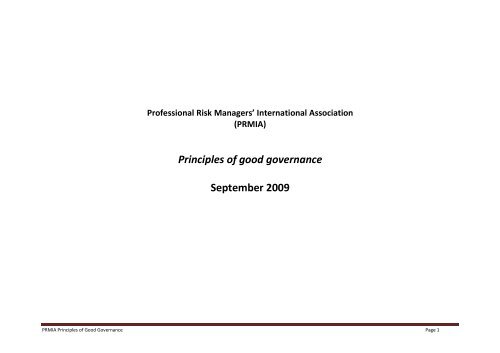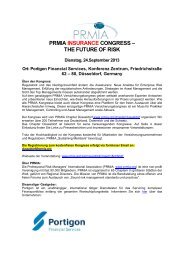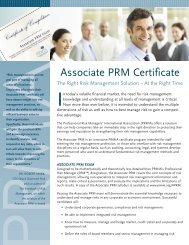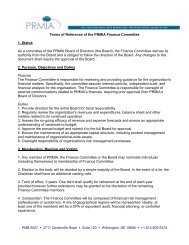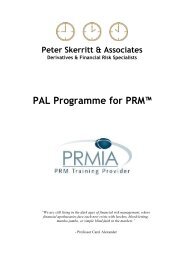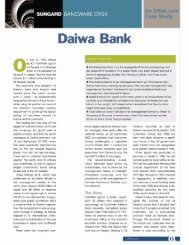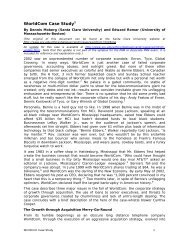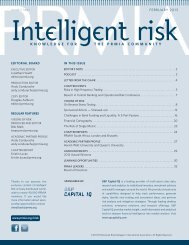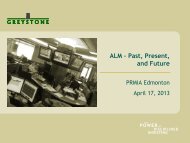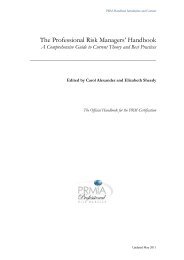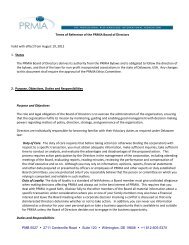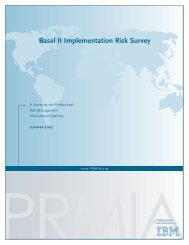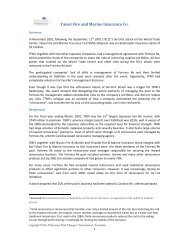Principles of good governance September 2009 - PRMIA
Principles of good governance September 2009 - PRMIA
Principles of good governance September 2009 - PRMIA
Create successful ePaper yourself
Turn your PDF publications into a flip-book with our unique Google optimized e-Paper software.
Pr<strong>of</strong>essional Risk Managers’ International Association<br />
(<strong>PRMIA</strong>)<br />
<strong>Principles</strong> <strong>of</strong> <strong>good</strong> <strong>governance</strong><br />
<strong>September</strong> <strong>2009</strong><br />
<strong>PRMIA</strong> <strong>Principles</strong> <strong>of</strong> Good Governance Page 1
I. PURPOSE<br />
As an independent association <strong>of</strong> pr<strong>of</strong>essional risk managers from diverse industries in more than 150 countries, <strong>PRMIA</strong> provides the premier meeting place for<br />
financial and non-financial organisations, their stakeholders and their regulators to engage in, and verify the existence <strong>of</strong>, best practice corporate <strong>governance</strong>.<br />
The tool we use is the <strong>PRMIA</strong> <strong>Principles</strong> <strong>of</strong> Good Governance.<br />
This document sets out principles for <strong>good</strong> <strong>governance</strong> and risk management using the following definitions:<br />
Governance The framework <strong>of</strong> authority for an organisation within which its institutional objectives are pursued and within which risk<br />
management operates.<br />
Risk Unknown future circumstances that alter the value or well-being <strong>of</strong> an organisation or system.<br />
Risk Event The realisation <strong>of</strong> a specific circumstance that decreases (but could unexpectedly increase) the value or well-being <strong>of</strong> an<br />
organisation or system.<br />
Risk Management The process <strong>of</strong> evaluating the potential impact <strong>of</strong> risk events and shaping business decisions in light <strong>of</strong> this evaluation.<br />
Board <strong>of</strong> Directors<br />
A body <strong>of</strong> elected or appointed members who jointly oversee the activities <strong>of</strong> a company or organisation – also referred to<br />
as board <strong>of</strong> trustees, board <strong>of</strong> governors, board <strong>of</strong> managers, executive board, etc. The precise responsibilities invested in<br />
the Board may differ from country to country.<br />
The ten principles below have been gleaned from international sources, both commercial and non-commercial, and from various disciplines, all addressing<br />
aspects <strong>of</strong> <strong>good</strong> <strong>governance</strong>. They are designed to be cross-cultural norms which provide Boards <strong>of</strong> Directors, Audit Committees and senior executives with a<br />
standard framework for effective <strong>governance</strong>. They also seek to provide regulators and auditors with an evaluation tool to ensure that effective <strong>governance</strong> is in<br />
place.<br />
Best practice <strong>governance</strong> and risk management do not attempt to eliminate risk. Rather, they are designed to help organisations maximise the risk-adjusted<br />
return on capital whilst, at the same time, transforming uncertainty - which is unmanageable and unmeasurable - into risk, which can be identified, assessed and<br />
may be measurable.<br />
Decision-making in business is predicated on a belief in potential rewards, balanced with the knowledge, understanding and appreciation <strong>of</strong> all <strong>of</strong> the risks taken<br />
to pursue those potential rewards. The key individuals involved in <strong>governance</strong> and risk management (see section IV <strong>of</strong> this document) have a responsibility to<br />
stakeholders, including the general public, as well as to financial stability. They must ensure that they do not give disproportionate weight to personal gain, or to<br />
the benefit <strong>of</strong> the organisation, to the detriment <strong>of</strong> public <strong>good</strong> and <strong>of</strong> financial stability.<br />
<strong>PRMIA</strong> <strong>Principles</strong> <strong>of</strong> Good Governance Page 2
II. THE PRINCIPLES<br />
These ten principles <strong>of</strong> corporate <strong>governance</strong> are based on common themes in a variety <strong>of</strong> sources (see section V <strong>of</strong> this document):<br />
1 Key Competencies<br />
2 Resources and Processes<br />
3 Ongoing Education and Development<br />
4 Compensation Architecture<br />
5 Independence <strong>of</strong> Key Parties<br />
6 Risk Appetite<br />
7 External Validation<br />
8 Clear Accountability<br />
9 Disclosure and Transparency<br />
10 Trust, honesty and fairness <strong>of</strong> key people<br />
N.B. The principles have not been prioritised in any way as they are inextricably interrelated and no one principle is more important than any other.<br />
Key Competencies<br />
The organisation should have at its disposal employees who have adequate knowledge, skills and expertise to perform the tasks assigned to them. These<br />
competencies can be gained through pr<strong>of</strong>essional qualification or by experience in role.<br />
Resources and Processes<br />
Adequate levels <strong>of</strong> resource shall be in place to enable the organisation to operate effectively. The business and technological processes shall be fit for purpose.<br />
Ongoing Education and Development<br />
The organisation shall encourage all employees to keep abreast <strong>of</strong> the latest developments in their particular areas <strong>of</strong> expertise, through courses, conferences,<br />
journals and other education channels and shall make adequate resources available to enable this to occur.<br />
Compensation Architecture<br />
Employees should be remunerated adequately for the roles that they perform, where ‘adequately’ is defined using external references and benchmarks, and in a<br />
framework which is consistent with the type <strong>of</strong> risk-taking behaviour expected <strong>of</strong> the employee.<br />
Independence <strong>of</strong> Key Parties<br />
The organisation shall ensure that, at all times, key checks and balances are in place to assure effective <strong>governance</strong>. Functions such as Audit and Risk<br />
Management are to be independent and report directly to through senior management rather than through those for whom they serve as a check and balance.<br />
<strong>PRMIA</strong> <strong>Principles</strong> <strong>of</strong> Good Governance Page 3
Risk Appetite<br />
The Board <strong>of</strong> Directors <strong>of</strong> an organisation shall determine, and <strong>of</strong>ficially record, its appetite for each category <strong>of</strong> risk within its published risk framework. It shall<br />
encourage a cascade <strong>of</strong> this approach throughout the whole <strong>of</strong> the organisation. Such appetite must be expressed in a measurable way that can inform decisions<br />
at lower levels in the organisation.<br />
External Validation<br />
All aspects <strong>of</strong> the <strong>governance</strong> framework <strong>of</strong> the organisation shall be periodically validated by an independent body or bodies, external to the organisation, to<br />
ensure that they are appropriate to the sector and geographies in which the organisation operates and consistent with the stated policies and public<br />
representations made by the organisation.<br />
Clear Accountability<br />
At all levels in the organisation, accountabilities should be clearly defined. Individuals should be clearly advised <strong>of</strong> their own accountabilities and <strong>of</strong> the<br />
consequences <strong>of</strong> not fulfilling them in a timely and appropriate manner.<br />
Disclosure and Transparency<br />
The Board <strong>of</strong> Directors and senior management shall adopt an approach <strong>of</strong> disclosure and transparency consistent with their stated policies and ensure that this<br />
approach is followed at all levels throughout the organisation.<br />
Trust, honest and fairness <strong>of</strong> key people<br />
The key people involved in the application <strong>of</strong> <strong>good</strong> <strong>governance</strong> and risk management must be trustworthy and honest and treat others fairly at all times.<br />
<strong>PRMIA</strong> <strong>Principles</strong> <strong>of</strong> Good Governance Page 4
III. APPLICATION OF THE PRINCIPLES<br />
The essence <strong>of</strong> <strong>good</strong> corporate <strong>governance</strong> is a deliberate and sustained effort to adhere to the principles defined above. These principles are applied in the<br />
following areas:<br />
• Board <strong>of</strong> Directors including the Audit and Risk Committees<br />
• Risk Management Infrastructure<br />
• Financial Accounting and Reporting Infrastructure<br />
• The organisation as a whole<br />
The tables below provide an introductory checklist to the ways in which the <strong>PRMIA</strong> <strong>Principles</strong> <strong>of</strong> Good Governance are to be applied in each <strong>of</strong> these four areas.<br />
Requirement<br />
Boards <strong>of</strong> Directors, including Audit and Risk Committees, must:<br />
• be aware <strong>of</strong> the business structure and environment in which the organisation operates and<br />
understand how the Risk Management Infrastructure has been designed to address the risks<br />
encountered in that environment<br />
• be composed in a manner such that sufficient independence and expertise exist to evaluate<br />
competently the business structure and environment in which the organisation operates<br />
<strong>Principles</strong><br />
<strong>PRMIA</strong> <strong>Principles</strong> <strong>of</strong> Good Governance Page 5<br />
Key Competencies<br />
Resources and<br />
Processes<br />
Ongoing Education<br />
and Discernment<br />
Compensation<br />
Architecture<br />
Independence <strong>of</strong><br />
Key parties<br />
Risk appetite<br />
External Validation<br />
Clear<br />
Accountability<br />
Disclosure and<br />
Transparency<br />
Trust, honesty and<br />
fairness <strong>of</strong> key<br />
people<br />
<br />
<br />
• define the risk appetite <strong>of</strong> the organisation and articulate this clearly to senior management <br />
• set a policy for compensation and targets which supports the Board <strong>of</strong> Directors’ commercial<br />
strategy and which encourages employees to operate within its risk appetite<br />
• review thoroughly compensation plans <strong>of</strong> potentially "highly compensated positions" for<br />
consistency with corporate risk appetite, competitive market conditions and fiduciary responsibility<br />
to shareholders<br />
• delegate – to one <strong>of</strong> their number – formal responsibility for understanding, in detail, the Risk<br />
Management Infrastructure <strong>of</strong> the organisation and for reporting regularly, to the Board <strong>of</strong><br />
Directors / Committee on the effectiveness <strong>of</strong> that Infrastructure<br />
• review continually the application <strong>of</strong> the <strong>Principles</strong> <strong>of</strong> Good Governance to the Risk Management<br />
Infrastructure, financial accounting and reporting infrastructure and the organisation as a whole<br />
<br />
<br />
<br />
<br />
• be fully accountable to shareholders and work to the benefit <strong>of</strong> public <strong>good</strong> and <strong>of</strong> financial stability
The Risk Management Infrastructure must:<br />
Requirement<br />
• be independently staffed and report to an employee who is on the Executive Committee (Operating<br />
Committee), but who is not a business unit leader<br />
• possess sufficient funding, intellectual and technological capacity to understand and communicate<br />
the risks presented by the business structure and environment<br />
<strong>Principles</strong><br />
<strong>PRMIA</strong> <strong>Principles</strong> <strong>of</strong> Good Governance Page 6<br />
Key Competencies<br />
Resources and<br />
Processes<br />
Ongoing Education<br />
and Discernment<br />
Compensation<br />
Architecture<br />
Independence <strong>of</strong><br />
Key parties<br />
Risk appetite<br />
External Validation<br />
Clear<br />
Accountability<br />
Disclosure and<br />
Transparency<br />
Trust, honesty and<br />
fairness <strong>of</strong> key<br />
people<br />
<br />
<br />
• avoid silos <strong>of</strong> control and oversight <br />
• include financial risk management, compliance and external reporting and, to the extent that<br />
resources allow, should exclude legal or accounting<br />
• define the organisation’s definition <strong>of</strong> risk management as articulated by the Board in clear and<br />
unmistakable terms<br />
• implement and maintain an approval and implementation process which ensures that the<br />
organisation’s compensation and targets policy does not compromise the risk management<br />
framework and risk appetite policies<br />
• have a budget that is established by a subset <strong>of</strong> the Executive Committee or Board, excluding the<br />
influence <strong>of</strong> individual business-unit leaders<br />
• provide a clear Escalation Policy, for the employees <strong>of</strong> the organisation as a Whole, to escalate<br />
matters <strong>of</strong> concern without the threat <strong>of</strong> inappropriately adverse impact<br />
• actively provide ongoing pr<strong>of</strong>essional development for risk management staff and require them to<br />
be committed to standards <strong>of</strong> best practice, conduct and ethics in their work<br />
• provide general risk management and related corporate <strong>governance</strong> training for employees <strong>of</strong> the<br />
organisation as a Whole – responsibility for the implementation <strong>of</strong> a risk culture rests with the risk<br />
management infrastructure<br />
• provide, in the organisation's Annual Report to Shareholders, a detailed description <strong>of</strong> the Risk<br />
Management Infrastructure
Requirement<br />
The Financial Accounting and Reporting Infrastructure must:<br />
<strong>Principles</strong><br />
• represent accurately, and in a timely manner, the current financial condition <strong>of</strong> the organisation <br />
• only use those <strong>of</strong>f-balance sheet transactions which have a legitimate economic, tax, risk transfer<br />
or risk mitigating purpose. All such transactions must be reported completely, equally, clearly and<br />
visibly (i.e. not be buried in the footnotes)<br />
• provide to the Board and Audit Committee an auditable Annual Statement <strong>of</strong> Compliance with the<br />
Board’s publicly stated Standards <strong>of</strong> Corporate Governance<br />
The organisation as a whole must:<br />
• provide ongoing education and training to all employees on the role <strong>of</strong> risk management and<br />
corporate <strong>governance</strong> in the organisation<br />
<strong>PRMIA</strong> <strong>Principles</strong> <strong>of</strong> Good Governance Page 7<br />
Key Competencies<br />
Resources and<br />
Processes<br />
Ongoing Education<br />
and Discernment<br />
Compensation<br />
Architecture<br />
Independence <strong>of</strong><br />
Key parties<br />
Risk appetite<br />
External Validation<br />
Clear<br />
Accountability<br />
Disclosure and<br />
Transparency<br />
<br />
<br />
• provide an environment in which a Risk Escalation Policy can be effective <br />
• enforce corporate <strong>governance</strong> polices <br />
• comply fully with local laws and regulations, and should comply with local customs, to the extent<br />
that such customs do not conflict with local laws and regulations<br />
• publish an external auditor's opinion that the organisation is in compliance with the Board’s<br />
publicly stated Standards <strong>of</strong> Corporate Governance<br />
• work within a policy for compensation and targets which supports the Board <strong>of</strong> Directors’<br />
commercial strategy and its risk appetite policies<br />
• ensure that there is a <strong>good</strong> flow <strong>of</strong> employees between business functions and <strong>governance</strong> and risk<br />
management functions<br />
<br />
<br />
<br />
<br />
• ensure that the organisation establishes and maintains a risk culture throughout the organisation <br />
<br />
Trust, honesty and<br />
fairness <strong>of</strong> key<br />
people
IV. DUTIES OF KEY PARTIES<br />
The following defines the roles and the expectations <strong>of</strong> key parties as they relate to risk-taking, risk management and <strong>governance</strong>. It is recommended that the<br />
risk function is directly represented at the most senior committee within the organisation.<br />
Members <strong>of</strong> the Board<br />
Act as sponsors for risk throughout the organisation and ensure that a risk culture is implemented, and maintained, from the top down. Are responsible for<br />
setting the risk appetite for the organisation and for ensuring that this is cascaded throughout the organisation.<br />
The Board member responsible for risk management reporting<br />
Ensures that risk reporting is produced in an accurate and timely manner and, where the intended readership is external to the organisation, that the reporting<br />
is accompanied by adequate interpretation which gives a complete picture <strong>of</strong> the risk landscape <strong>of</strong> the organisation.<br />
Chief Executive Officer<br />
Is responsible for ensuring that all <strong>of</strong> the operations <strong>of</strong> the organisation are carried out with due consideration <strong>of</strong> the risk appetite <strong>of</strong> the organisation and that<br />
the accompanying risks are understood and taken into account when doing business.<br />
Chief Financial Officer<br />
Must ensure that all <strong>of</strong> the risks associated with the key processes that contribute to the financial reporting <strong>of</strong> the organisation have been identified and that<br />
effective controls are in place to mitigate these risks to an acceptable level.<br />
Chief Risk Officer<br />
Responsible for the management <strong>of</strong> the Risk Management Infrastructure. Helps the Board to determine the risk appetite <strong>of</strong> the organisation and then<br />
implements this, throughout the organisation, through the Risk Management Infrastructure. Ensures that reporting <strong>of</strong> risk and <strong>governance</strong>-related matters is<br />
produced in a timely and accurate manner.<br />
The tenure and independence <strong>of</strong> the Chief Risk Officer should be underpinned by a provision that removal from <strong>of</strong>fice would require the prior agreement <strong>of</strong> the<br />
board. The remuneration <strong>of</strong> the Chief Risk Officer should be subject to approval by the chairman or chairman <strong>of</strong> the board remuneration committee.<br />
Internal Audit management<br />
Must maintain appropriate assurance measures to ensure that the Governance and Risk Framework <strong>of</strong> the organisation is effective and, if any shortcomings are<br />
discovered, to escalate these so that remedial action can be taken in an appropriate and timely manner.<br />
Compliance management<br />
Must ensure that all employees understand the rules and regulations (both internal and external) with which they must comply and the implications, for them<br />
and for the organisation, <strong>of</strong> non-compliance. Management <strong>of</strong> the compliance function must ensure that the organisation does comply with all relevant<br />
regulation and that adequate <strong>governance</strong> is in place to facilitate this.<br />
Other senior management within the organisation<br />
Has a responsibility to ensure that the <strong>governance</strong> and Risk Framework are embedded within their business area and, by rolling out a risk culture, that all<br />
employees understand their roles and responsibilities with regard to risk.<br />
<strong>PRMIA</strong> <strong>Principles</strong> <strong>of</strong> Good Governance Page 8
V. SOURCE DOCUMENTS<br />
• COSO Framework (Committee <strong>of</strong> Sponsoring Organizations <strong>of</strong> the Treadway Commission)<br />
• O'Malley Panel on Audit Effectiveness<br />
• OECD (Organisation for Economic Co-operation and Development) <strong>Principles</strong> <strong>of</strong> Corporate Governance<br />
• International Corporate Governance Network - Statement on Global Corporate Governance <strong>Principles</strong><br />
• Commonwealth Association for Corporate Governance <strong>Principles</strong> <strong>of</strong> Corporate Governance<br />
• Blue Ribbon Panel on Audit Committee Effectiveness<br />
• Greenbury Recommendations on Board Compensation<br />
• Basel Committee - Risk Concentration <strong>Principles</strong><br />
• Basel Committee - Enhancing Corporate Governance for Banking organisation<br />
• PAIB/IFAC Enterprise Governance <strong>Principles</strong><br />
• External Environmental Factor Considerations for Boards and Audit Committees - Ernst and Young<br />
• Sarbanes-Oxley Act<br />
• Securities and Exchange Commission<br />
• Group <strong>of</strong> 30 Reports<br />
• The Turner Review: A regulatory response to the global banking crisis – Financial Services Authority<br />
• CFA Institute Code <strong>of</strong> Ethics and Standards <strong>of</strong> Pr<strong>of</strong>essional Conduct<br />
• The Walker Review: A review <strong>of</strong> corporate <strong>governance</strong> in UK banks and other financial Industry entities – Financial Services Authority<br />
<strong>PRMIA</strong> <strong>Principles</strong> <strong>of</strong> Good Governance Page 9
VI. REVIEW COMMITTEE<br />
Dr. John Paul Broussard Associate Pr<strong>of</strong>essor, Rutgers University<br />
Frank Hayden Managing Director - Market Risk, Fortis Bank<br />
Kruskal Hewitt Senior Advisor, Risk Management – J Power, Electric Power Development, Japan<br />
David Koenig Chief Executive Officer the Governance Fund LLC<br />
Past Chair and Executive Director <strong>of</strong> <strong>PRMIA</strong><br />
Robert W. Kolb Pr<strong>of</strong>essor <strong>of</strong> Finance and Frank W. Considine Chair <strong>of</strong> Applied Ethics, Loyola University, Chicago<br />
Colin Lawrence Director <strong>of</strong> Risk, Financial Services Authority<br />
Steven Lindo Principal, SRL Advisory Services<br />
Past Executive Director <strong>of</strong> <strong>PRMIA</strong><br />
Renato Maino Pr<strong>of</strong>essor <strong>of</strong> Credit Risk Management, Milan L. Bocconi and Turin Universities<br />
Robert Mark Chief Executive Office <strong>of</strong> Black Diamond Risk<br />
Deputy Chair <strong>of</strong> the <strong>PRMIA</strong> Executive Board<br />
Colin Stringer Director <strong>of</strong> Parascosa Consulting<br />
Kalyan Sunderam Retired, past Chief Risk Officer and Deputy Chief Executive Officer - Bahraini Saudi Bank<br />
Desheng Dash Wu Affiliate Pr<strong>of</strong>essor, RiskLabs China Research Centre, Toronto University<br />
Version 4.4<br />
15 th <strong>September</strong> <strong>2009</strong><br />
<strong>PRMIA</strong> <strong>Principles</strong> <strong>of</strong> Good Governance Page 10


